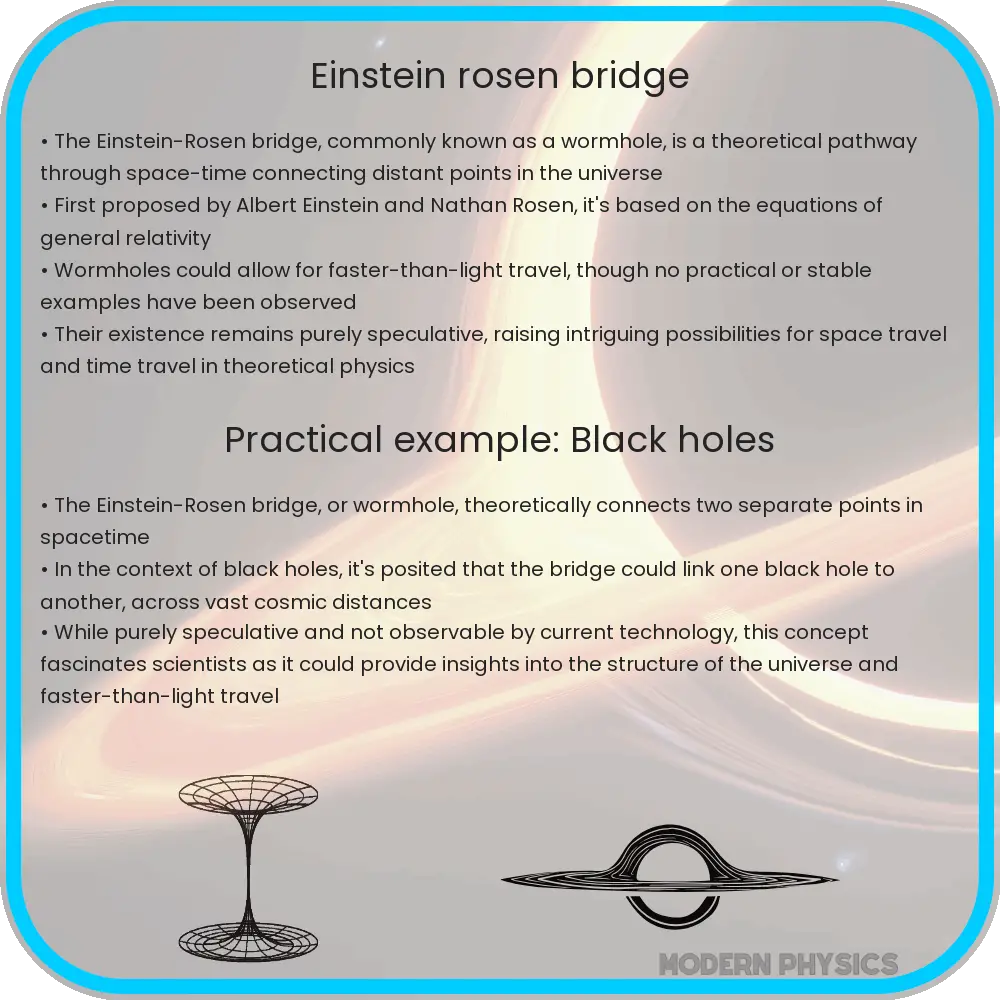Explore the enigmatic world of Einstein-Rosen Bridges and wormholes, delving into their theoretical foundations, types, and future implications.

Unraveling the Mystery of Einstein-Rosen Bridges and Wormholes
The concept of the Einstein-Rosen Bridge, more commonly known as a wormhole, is a fascinating facet of theoretical physics that bridges the realms of reality and science fiction. Stemming from Albert Einstein’s theory of general relativity, this hypothetical passage through space-time proposes a shortcut between distant points in the universe. In this article, we delve into the intriguing aspects of wormholes, exploring their theoretical foundations and potential implications in the realm of space exploration and beyond.
Theoretical Foundations of Wormholes
At the heart of wormhole theory lies the Einstein-Rosen Bridge, first proposed by Albert Einstein and physicist Nathan Rosen in 1935. This theoretical construct emerged from the solutions to the equations of general relativity, which describe the fundamental interaction of gravitation as a result of space-time being curved by matter and energy. Einstein and Rosen envisioned a bridge-like feature of space-time, connecting two separate points in the universe through a tunnel-like structure.
Understanding Space-Time and the Wormhole Concept
Space-time, a four-dimensional continuum comprising the three dimensions of space and one of time, is a core concept in understanding wormholes. In the context of general relativity, massive objects cause a distortion in space-time, which is perceived as gravity. A wormhole is theorized to be a tunnel with two ends, each at separate points in space-time. This tunnel would theoretically allow for quicker travel between these two points than would be possible through normal space.
Types of Wormholes
Wormholes are categorized into two main types: traversable and non-traversable. Traversable wormholes would allow matter to pass through, potentially enabling space travel across vast distances or even time travel. Non-traversable wormholes, on the other hand, are more aligned with the original Einstein-Rosen Bridge concept, where the tunnel collapses too quickly for anything to cross from one end to the other.
Challenges and Controversies
Despite their theoretical appeal, wormholes pose significant scientific and technical challenges. One major issue is the requirement of ‘exotic matter’ to keep the wormhole open. Exotic matter, which has negative energy density and pressure, is necessary to prevent the wormhole from collapsing but has not been observed in nature. Furthermore, the stability of wormholes and the feasibility of creating or finding one large enough for a spacecraft to traverse remain major hurdles.
Moreover, the concept of wormholes treads a fine line between science and speculation, often stirring debates among physicists. While mathematically plausible, the lack of empirical evidence makes wormholes a topic of ongoing research and intense discussion in the scientific community.
Wormholes in Science and Science Fiction
The allure of wormholes extends beyond theoretical physics into the realm of science fiction. Popular culture often depicts wormholes as gateways to other galaxies or times, a concept that, while fascinating, is far from our current scientific capabilities. However, these imaginative portrayals have played a significant role in popularizing complex scientific concepts and sparking public interest in space exploration and theoretical physics.
Recent Developments in Wormhole Research
In recent years, there have been some intriguing developments in wormhole research. Advanced computer simulations and new theoretical models have provided deeper insights into the potential properties and behaviors of wormholes. While these studies are still in the realm of theoretical physics, they offer a glimpse into the possibilities that wormholes could hold for future scientific breakthroughs.
Implications for the Future
The study of wormholes could have profound implications for our understanding of the universe. If traversable wormholes are possible, they could revolutionize space travel, allowing us to reach distant parts of the universe in a fraction of the time it would take with current technology. Additionally, wormholes might provide insights into the nature of space-time itself, potentially leading to new discoveries in physics and cosmology.
Conclusion
While the existence and practicality of wormholes remain within the theoretical realm, their study continues to captivate scientists and the public alike. The Einstein-Rosen Bridge and the concept of wormholes represent a fascinating intersection of theoretical physics, mathematics, and imagination. Whether or not wormholes will ever become a reality, their exploration has undeniably expanded our understanding of the universe and inspired countless individuals to look up at the stars and wonder. As science advances, the boundaries between the possible and the impossible continue to blur, leaving us to dream about what might lie beyond the horizon of our current knowledge.
Is this conversation helpful so far?
